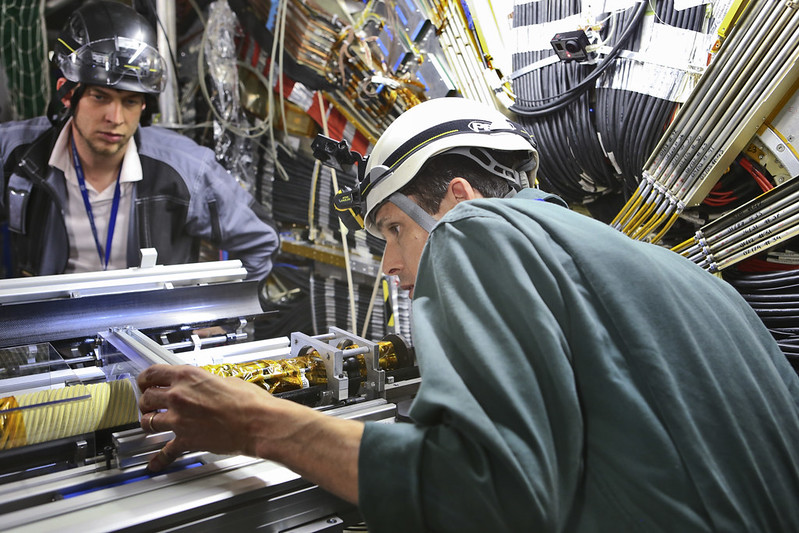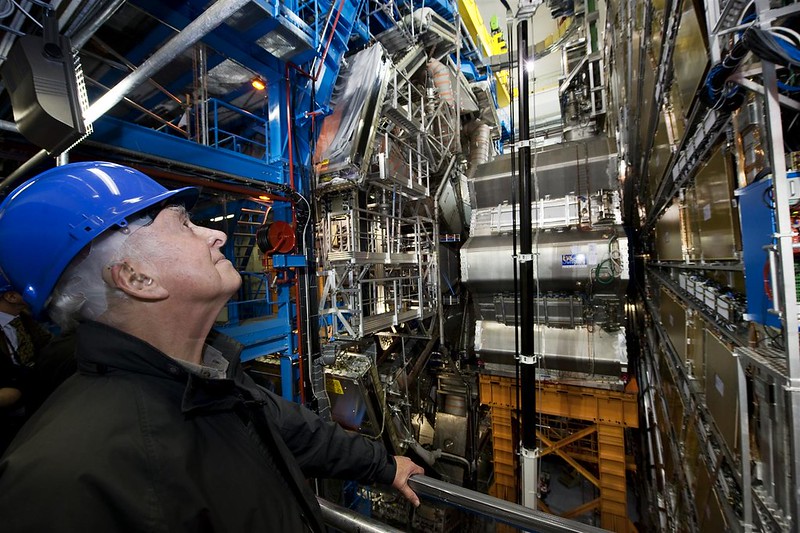Washington College Becomes Member of International ATLAS Collaboration
Assistant Professor of Physics Suyog Shrestha and Washington students join members from 180 institutions around the world to conduct global, cutting-edge research in particle physics.

Physicists installing a new component in the Atlas Experiment Equipment. Photo Credit: CERN
Thousands of researchers from more than 100 countries around the world work together at the European Organization for Nuclear Research, known as CERN, to study the building blocks of matter and fundamental forces shaping our universe. In 2012, two experiments at CERN caught the world's attention when they used the Large Hadron Collider to create and record for the first time the Higgs boson, a subatomic particle predicted in the 1960s.
The institutions that contribute to CERN's research, both in Geneva and remotely by analyzing data and carrying out detector research and development, are among the best in the world, including Harvard, Columbia, Oxford, and Cambridge universities. And as of this academic year, Washington College was officially admitted as an associate institution member of the ATLAS Collaboration, which comprises 180 universities and national laboratories. Washington became just the third small liberal arts school to join the ATLAS Collaboration.
Assistant Professor of Physics Suyog Shrestha led the effort resulting in membership, proposing to study one of the properties of the Higgs boson, which still requires extensive investigation now that it has been discovered. Shrestha spent 10 years working at CERN, first as a Ph.D. student, then as a postdoctoral researcher before joining the Washington College physics faculty in 2022. He was part of the team of 6,000 scientists whose work led to the discovery of the Higgs boson in 2012, resulting in the 2013 Nobel Prize in Physics for theorists who predicted the existence of this particle decades before.
Shrestha currently has two Washington students working on the project, Sneha Dixit '23 and Jason Ikenaga '24, providing an invaluable opportunity for the students to contribute to cutting-edge research. Washington College's associate membership is hosted by The Ohio State University (OSU), providing additional opportunities for Dixit and Ikenaga to collaborate with colleagues at a large research university.
"To be accepted as member of the ATLAS Collaboration, a new group is required to fulfill certain criteria,” said ATLAS spokesperson Andreas Hoecker. “Dr. Shrestha has been a highly effective and esteemed researcher at the ATLAS Experiment since 2009. The association of Washington College to ATLAS under Dr. Shrestha's leadership was strongly supported by the OSU ATLAS group leader through which the association is managed, the US-ATLAS Contact Physicist and Operations & Research Programme Manager, as well as ATLAS Management.”
Dixit first worked with Shrestha in the summer of 2021, supported by the College's John S. Toll Science and Math Fellows Program. In 2022 she worked with Digesh Raut, a visiting assistant professor at Washington and particle physicist on a separate research project on dark matter, but "both projects have particle physics theories in common” and studying one helped her understand the other, according to Dixit.
Not only have the complementary research opportunities deepened Dixit's knowledge, they also gave her the skills and experience to win the US ATLAS Summer Undergraduate Program for Exceptional Researchers (SUPER) award—funding that will allow her to continue working on Shrestha's project for eight weeks this summer after she graduates. According to Shrestha, Dixit's years of research while a student at Washington also means her work under the SUPER award will be able to benefit the ATLAS experiment at large.
“Here is a very strong student who has worked with me in the past and has learned the skills. Now she is really at the point where she can make an impact,” he said. “Whatever her findings are will stay with us after she graduates. She is, at the moment, functioning like a graduate student.”
 Peter Higgs, for whom the Higgs boson is named, visited the ATLAS experiment four
years before the famous Higgs discovery. Photo Credit: CERN
Peter Higgs, for whom the Higgs boson is named, visited the ATLAS experiment four
years before the famous Higgs discovery. Photo Credit: CERN
The current theory underpinning scientists' understanding of nature at the smallest scale is called the Standard Model, and it explains much of how our universe works. Standard Model insights are integral to much of modern electronics. The Standard Model predicted the Higgs boson decades before its discovery. But it doesn't adequately explain everything, and Shrestha notes that as experimentalists, he and his colleagues in the ATLAS Collaboration aim to test the weaknesses of the theory to either prove or disprove certain aspects of it.
In addition to predicting the Higgs boson, the Standard Model indicates the particle should be able to interact with itself, a unique phenomenon that will result in the production of two Higgs bosons in the same proton-proton collision event. This unique property of the Higgs boson is called Higgs self-coupling, and such events are called Di-Higgs events.
Dixit is using simulations to study features of the Di-Higgs process that will allow physicists to measure the Higgs self-coupling. The Standard Model predicts a precise value of the Higgs self-coupling, and the experimentalists are carrying out the measurements to test if the theory is correct, or if the theory fails. Failure of the theory won't necessarily be a bad outcome, because it may lead to new developments in physics that could explain other cosmological observations, such as dark matter, that don't fit into the Standard Model. In any case, observing a Di-Higgs process is extremely rare, much rarer than observing a single Higgs boson in 2012. Shrestha says it is “like looking for a needle in a haystack of needles.”
Dixit is a physics and mathematics double major, and Ikenaga is a computer science and mathematics double major. Shrestha says that particle physics requires scientists to be not just physicists but also computer scientists, engineers, mathematicians, and statisticians. Having one physics student and one computer science student working in the lab is purposeful.
Ikenaga supports the efforts to run simulations by maintaining the computer code that enables the work. He is excited by the opportunity to work on machine learning for collision predictions in Shrestha's lab and came from an internship in the Watershed Innovation Lab last year where he was working on robotics collecting water quality data.
“Machine learning is more theoretical. You're using it to predict stuff and analyze data. What I was doing in the robotics lab was more hardware, hands-on stuff,” Ikenaga said. Working in a research lab, let alone two, has set Ikenaga's experience apart from that of his friends at larger schools. “All of them have jobs, but there's no research jobs.”
While he still has a year to finish at Washington, Ikenaga is considering graduate school to continue researching machine learning and artificial intelligence.
Dixit has been accepted into the Ph.D. program at the University of Nebraska at Lincoln, where she will continue working with the Large Hadron Collider but on ATLAS' sister experiment, CMS. The two projects work in parallel but do not collaborate, using each other's results to confirm findings before publishing them if the findings have historical significance such as the discovery of the Higgs boson.
“I have learned so much physics outside of my required major-related coursework doing research over here. The amount of new physics I've learned—the depths into which I've been able to explore particle physics—is something that I didn't know would be possible,” Dixit said. “When I was growing up, while I really liked physics, I didn't know how long I would be able to pursue it, how long I'd be able to keep studying it. Coming here ... I was able to study physics during my undergraduate degree ... and now I'm able to extend that period and just keep studying what I like for longer. I just want to be immersed in this field of study that I enjoy for as long as possible.”